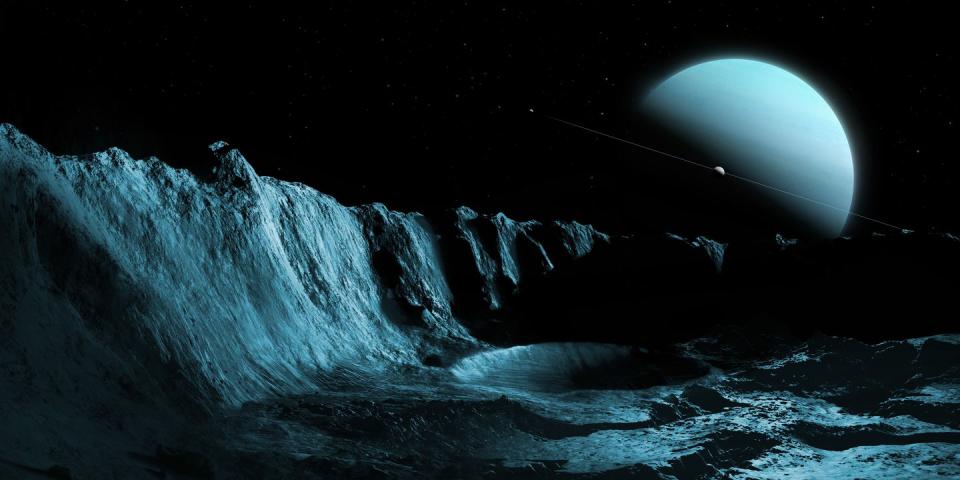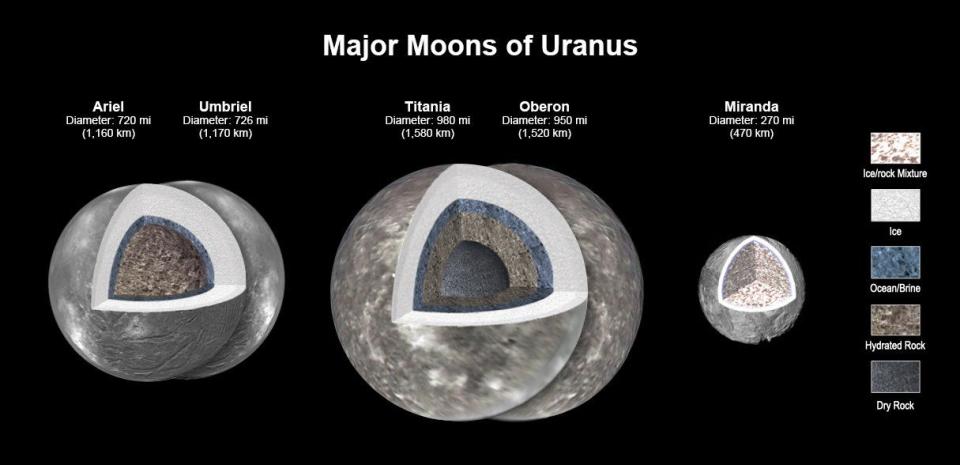The 4 Major Moons of Uranus May Have Underground Oceans—and Possibly Life Inside

A new study from NASA recently announced that four of Uranus’s five biggest moons may have liquid water oceans beneath their surface.
The research is based on models built from Voyager 2 data and additional information collected over the last 40 years.
With Uranus pinned as a prime target for investigation over the next 10 years, we may soon be able to follow these predictions up with first-hand observations.
Water, water everywhere—all throughout our Solar System, apparently. According to a new study led by NASA’s Jet Propulsion Laboratory (JPL), four out of five of Uranus’s largest moons may have vast subterranean oceans. And two of those moons may even have oceans warm enough to support life.
In a study recently published in the Journal of Geophysical Research, the research team worked to re-examine data on the moons—named Ariel, Umbriel, Oberon, Titania, and Miranda—from NASA’s Voyager 2 mission, which passed by the Uranus planetary system in the 1980s. The team incorporated that archival data and subsequent ground-based observations of the satellites into new models to better understand the makeup of these still mysterious objects.
According to a NASA press release, the models were “infused with additional findings from NASA’s Galileo, Cassini, Dawn, and New Horizons (each of which discovered ocean worlds), including insights into the chemistry and the geology of Saturn’s moon Enceladus, Pluto and its moon Charon, and Ceres—all icy bodies around the same size as the Uranian moons.”
Bringing together the information we have gathered on Uranus’s moons directly with our understanding of similarly sized objects throughout the Solar System (which has improved a lot since the 1980s), the new models were able to show us in a lot more detail what the layers of Uranus’s biggest moons probably look like. They also allow us to probe what materials make up the crusts of these satellites and what events—like potential icy volcanic eruptions—may have shaped their surfaces.
Of the five moons, the paper claims that all but Miranda likely harbor subterranean oceans, and that Oberon and Titania could theoretically harbor life in those waters. In the past, only Titania had been thought to be large enough to generate the necessary heat to form an underground ocean of water.

Now, the researchers suggest that the mantles of these moons may generate enough heat to keep their oceans liquid. In addition, the water present is likely mixed with substances like ammonia and salts, both of which are known to lower the freezing point of water significantly and keep it in liquid form at much lower temperatures than usual.
This study comes on the heels of the National Academies’ 2023 Planetary Science and Astrobiology Decadal Survey—also known simply as “the Decadal”—which is a once-in-a-decade plan published by members from across the astronomical community detailing wide-reaching goals for the next 10 years. 2023’s Decadal named the Uranus system as a prime target for investigation, and announced plans to send spacecraft to the planet in fairly short order to follow up on Voyager’s work.
But the implications of this study reach far past just the Uranus system. “When it comes to small bodies – dwarf planets and moons – planetary scientists previously have found evidence of oceans in several unlikely places, including the dwarf planets Ceres and Pluto, and Saturn’s moon Mimas,” Julie Castillo-Rogez, planetary scientists and lead author of the paper, said in a press release. “So there are mechanisms at play that we don’t fully understand. This paper investigates what those could be and how they are relevant to the many bodies in the solar system that could be rich in water but have limited internal heat.”
Hopefully, the investigation of Uranus and its satellites promised by the Decadal comes to fruition soon, and we can confirm these predictions with first-hand, on-planet data. But until then, we now have four more worlds in the Solar System with the promising potential of liquid water.
You Might Also Like
